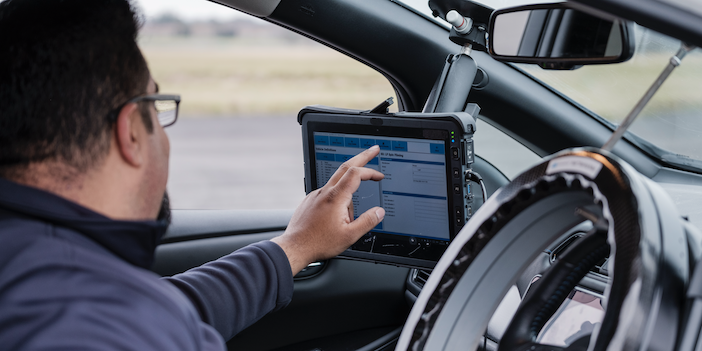Automotive testing technology supplier, AB Dynamics, has introduced configurable test groups in the latest version of its RC software, which enable the automation of Euro NCAP’s new 2024 assisted-driving tests.
Euro NCAP’s 2024 Assisted Driving Grading is designed to provide consumers with comprehensive data on the performance of assisted driving systems that will inform their purchasing decisions. The latest grading is designed for more thorough assessment of systems with a new protocol that introduces 40 new on-track tests that require driving robots and ADAS targets. This represents a doubling of the test effort.
“With its updated rating system, Euro NCAP is aiming to take the ambiguity out of the capability and performance of assisted driving technologies,” said Leo Evans, lead engineer at AB Dynamics. “This is great news for consumers, but does increase the test burden for OEMs and test houses. Our solution takes the pain out of creating and performing these test scenarios to increase efficiency and maximise track time.”
As a supplier of both driving robots and ADAS platforms, AB Dynamics can coordinate both the robot-controlled vehicle under test and the ADAS targets. This enables the creation, set-up and execution of complex multi-vehicle test scenarios, which can be automated through a single software ecosystem.
The company’s suite of configurable base scenarios covers all the relevant tests within the 2024 Assisted Driving protocol. This allows test engineers to run the specific test scenarios dictated by the protocol, or a range of iterations of the base scenario, varying aspects such as speed, distance and offset.
The Scenario Generator tool allows preplanning of trajectories, location and speed of all test objects, such as the vehicle under test and ADAS targets. The tests can be previewed using a pre-play function to check the setup is correct before running the scenario in the real world, while a post-test graphing software simplifies the analysis and reporting of data.

The tests are automatically reconfigured to account for different vehicle widths and lengths, to control the collision points precisely. The software also automatically runs cross-checks to ensure the test is defined properly according to the specific requirements. This includes aspects such as data capture rate and vehicle reference points. This is critical as any incorrect specifications will result in invalid data and wasted track time. The post-test processing tool validates the test data and provides a preliminary real-time pass or fail result.
The new scenarios introduced in Euro NCAP’s 2024 Assisted Driving protocol place a focus on how the systems interact with Vulnerable Road Users (VRUs), such as pedestrians, bicyclists and motorcyclists. The new test scenarios include the ACC (Adaptive Cruise Control) Car-to-Motorcyclist, Collision Avoidance Car-to-Motorcyclist, Car-to-Bicyclist, Car-to-Pedestrian and the Lane Support system – lane change with overtaking vehicle test scenarios.
“The 2024 update has introduced more challenging test scenarios to better assess the performance of assisted driving systems,” added Evans. “For example, motorcyclists can be difficult for the systems to detect and classify correctly, particularly when in close proximity to other vehicles. Completing a comprehensive and varied matrix of tests is the only way manufacturers can be confident their systems will not only pass the tests, but also perform in the real world.”





